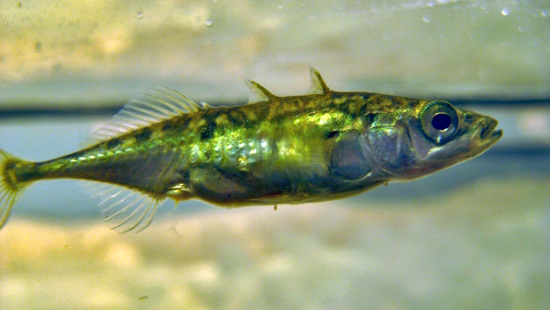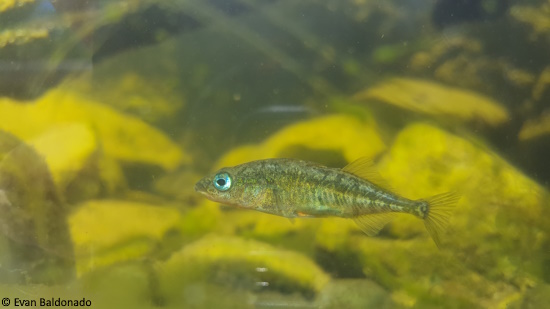
- Scientific name: Gasterosteus aculeatus
- Size: Up to 10cm
- UK minimum size: N/a
- UK shore caught record: 8 grams (listed as a freshwater record)
- IUCN Status: LC (Least Concern)
- Distribution: Found in both freshwater and saltwater throughout Europe and North America.
- Feeds on: Small sea creatures such as invertebrates and marine worms.
- Description: Small fish with three spines on its back forward of its dorsal fin. Colour is usually a mottled dark green/light green. Eyes are large in comparison to body size.
The three-spined stickleback is a species which is found throughout northern Europe. Populations are found in both freshwater and saltwater meaning it is found in rivers, estuaries and inshore coastal areas across the British Isles, Iceland and Scandinavia and along the Baltic and North Seas and also across rivers and lakes through central and eastern Europe. A separate population exists along both the east and west coasts (and rivers and lakes) of the North American continent. Around the British and Irish coastlines three-spined sticklebacks are found in shallow waters close to the shore. They are often found in rockpools and weed beds and in estuaries and any other areas of shelter such as coves and estuaries.
Very much a mini species, the three-spined stickleback can grow to 10cm (4 inches) in length but is typically half of this size. The three prominent spines on the back give this species its name. The colour is usually dark green to brown with a lighter green or yellow mottled pattern across the flanks. Males develop a bright red underbelly and throat during the breeding season in the spring and summer. In saltwater, this species feeds on small sea creatures such as marine worms and invertebrates, fish fry, eggs, and plankton. Outside the breeding season this species may form into shoals or small groups.

Like the sea stickleback, the male three-spined stickleback builds a nest during the breeding season out of seaweed and marine vegetation. He then carried out a courtship dance which consists of swimming in a zigzag pattern to attract a female. The female will then deposit eggs into the nest where the male will fertilise them. The male will then defend the nest until the eggs hatch. In saltwater it is believed that three-spined sticklebacks only spawn once before dying, but in freshwater they may spawn each year. Due to their complex behaviour and lifecycle, the three-spined stickleback has been subject to much interest from the scientific community. They are also popular to keep in aquariums. The International Union for Nature classes three-spined sticklebacks as a species of Least Concern both globally and in Europe and notes that there are no major threats to this species.
There is a British record for this species, a three-spined stickleback of 8 grams caught by Mat Faulkner at Lower Beauvale Ponds in Nottinghamshire in 2019. This broke the previous record of 7 grams set in 1998 by Dennis Flack. Due to the location of capture, this is recorded as a freshwater record and not a sea fishing record.